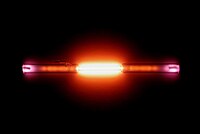
Photo from wikipedia
Abstract In ITER and future tokamaks, high heat flux loads will lead to recrystallization and decrease in toughness and thermal shock resistance of tungsten plasma facing materials, resulting in crack… Click to show full abstract
Abstract In ITER and future tokamaks, high heat flux loads will lead to recrystallization and decrease in toughness and thermal shock resistance of tungsten plasma facing materials, resulting in crack network formation and possible failure. In this study, thermal shock tests of blank, helium-plasma-exposed and helium-ion-irradiated rolled tungsten with/without isothermal annealing are conducted. Without annealing, cracks start to form in blank tungsten at the power density of 0.35 GW/m2, while no cracks are observed on the loaded surface of helium-plasma-exposed and helium-ion-irradiated ones. After annealing at 1473 K for 1 h, the recrystallization fractions of the three kinds of tungsten are around 50%, 18% and 8%, respectively. The following thermal shock tests of the annealed samples show that the cracking thresholds of blank and helium-plasma-exposed ones reduce to 0.3 GW/m2, while cracks do not appear in the helium-ion-irradiated one at this power density. Surface roughening thresholds are also improved in helium pre-implanted samples and do not change after annealing. It indicates that both helium plasma and ion irradiation improve the thermal stability and damaging threshold of tungsten, and helium ion irradiation has a stronger influence. This suggests a potential benefit of helium to extend the service lifetime of tungsten.
Journal Title: Nuclear materials and energy
Year Published: 2021
Link to full text (if available)
Share on Social Media: Sign Up to like & get
recommendations!